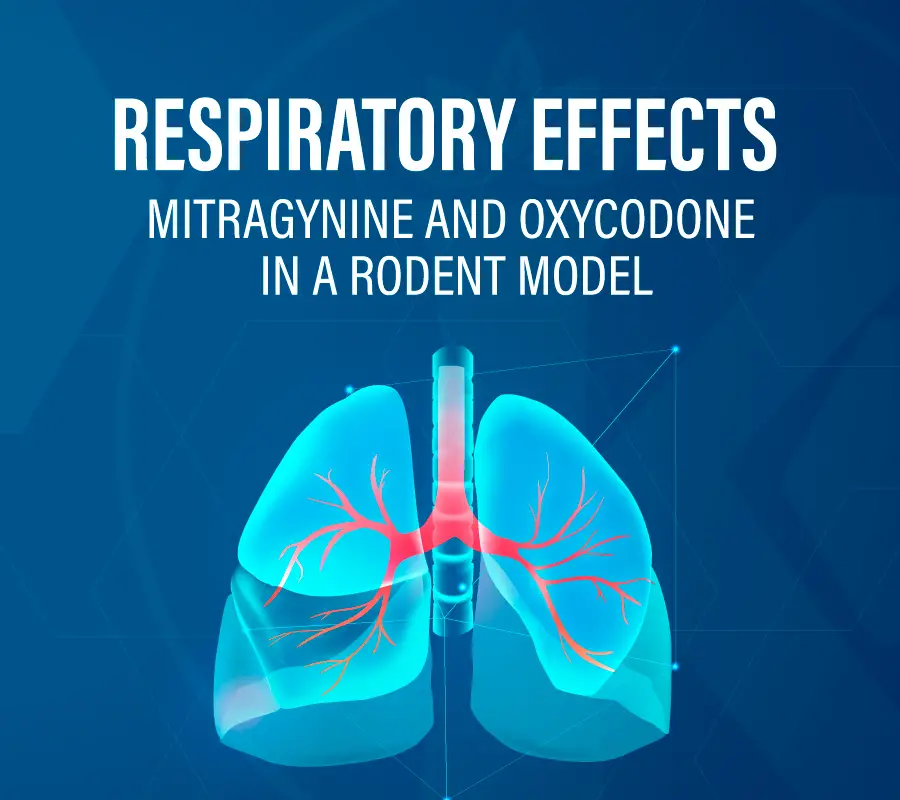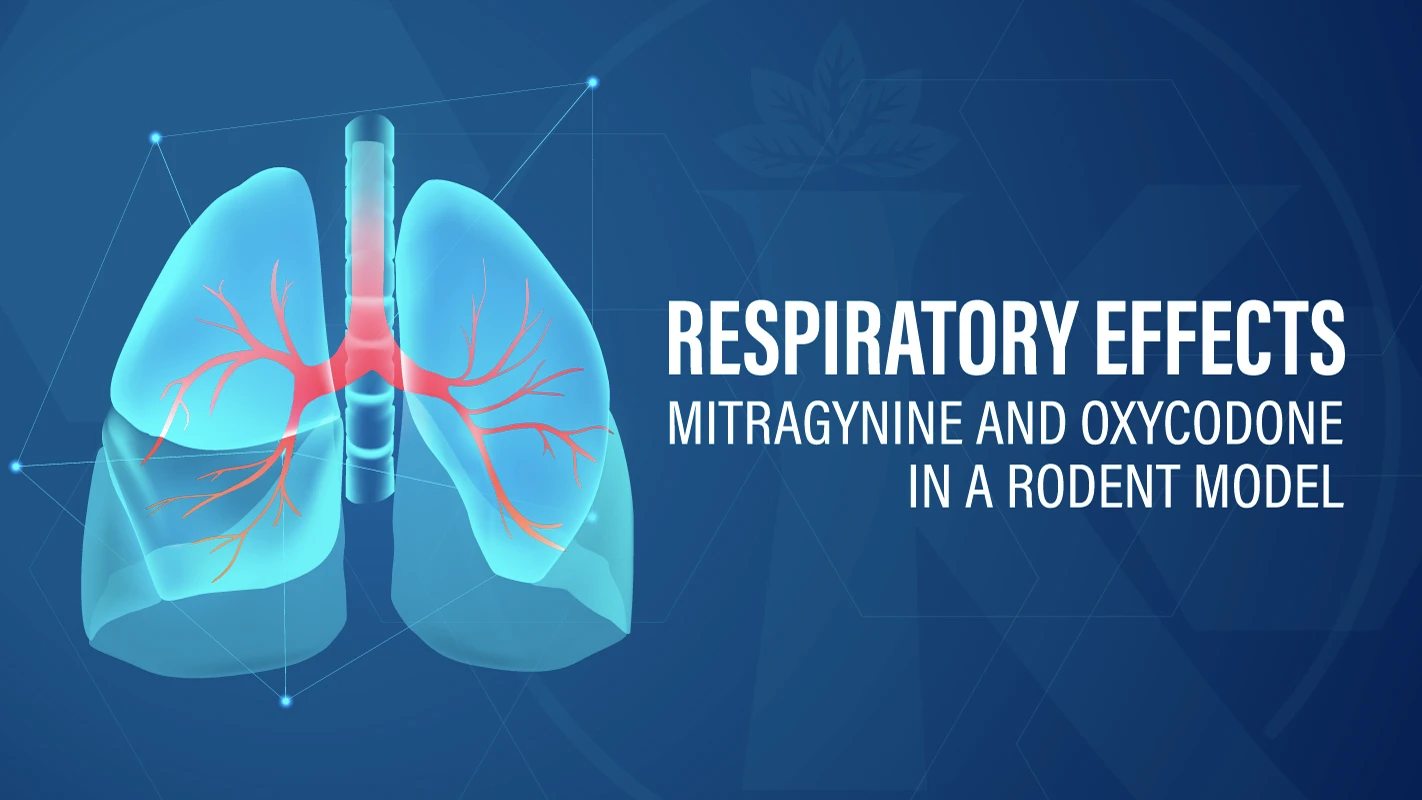Respiratory effects of oral mitragynine and oxycodone in a rodent model
Kratom derives from Mitragyna speciosa (Korth.), a tropical tree in the genus Mitragyna (Rubiaceae) that also includes the coffee tree.
Kratom leaf powders, tea-like decoctions, and commercial extracts are taken orally, primarily for health and well-being by millions of people globally. Others take kratom to eliminate opioid use for analgesia and manage opioid withdrawal and use disorder.
There is debate over the possible respiratory depressant overdose risk of the primary active alkaloid, mitragynine, a partial μ-opioid receptor agonist, that does not signal through ß-arrestin, the primary opioid respiratory depressant pathway.
Objectives
Compare the respiratory effects of oral mitragynine to oral oxycodone in rats with the study design previously published by US Food and Drug Administration (FDA) scientists for evaluating the respiratory effects of opioids (Xu et al., Toxicol Rep 7:188–197, 2020).
Methods
Blood gases, observable signs, and mitragynine pharmacokinetics were assessed for 12 h after 20, 40, 80, 240, and 400 mg/kg oral mitragynine isolate and 6.75, 60, and 150 mg/kg oral oxycodone hydrochloride.
Findings
Oxycodone administration produced significant dose-related respiratory depressant effects and pronounced sedation with one death each at 60 and 150 mg/kg. Mitragynine did not yield significant dose-related respiratory depressant or life-threatening effects. Sedative-like effects, milder than produced by oxycodone, were evident at the highest mitragynine dose. Maximum oxycodone and mitragynine plasma concentrations were dose related.
Conclusions
Consistent with mitragynine’s pharmacology that includes partial µ-opioid receptor agonism with little recruitment of the respiratory depressant activating β-arrestin pathway, mitragynine produced no evidence of respiratory depression at doses many times higher than known to be taken by humans.
Introduction
Kratom products are used globally for health and well-being, improved mood, sleep, attention, and coffee-caffeine-like alerting effects (Grundmann, 2017; Henningfield et al. 2018, 2022; Swogger et al. 2022). There is recreational use; however, many people who use opioids recreationally report kratom as a poor substitute for producing opioid-like euphoria but do find it useful to self-manage withdrawal and discontinue opioid use (Coe et al. 2019; Garcia-Romeu et al. 2020; Prozialeck et al. 2019; Swogger et al. 2022). Estimates of incidence and prevalence of intake vary from 2 to 16 million in the United States (US) (American Kratom Association 2019; Covvey et al. 2020; Henningfield et al. 2021; Palamar 2021; Schimmel et al. 2021) and many millions more globally, with the highest prevalence in Southeast Asia and Indonesia where kratom grows in abundance and has been widely consumed for centuries (Brown et al. 2017; Cinosi et al. 2015; Prozialeck et al. 2021; WHO ECDD 2021; Vicknasingam et al. 2010).
People also read: Kratom effects; Can You Overdose On Kratom?
Deaths attributed directly to kratom use in the US and globally are rare and were not documented in Southeast Asia (Prozialeck et al. 2019; Ramanathan and McCurdy 2020). Analyses of kratom-associated deaths found that most of such deaths are more likely attributed to the use of other substances and causes not related to kratom (Gershman et al. 2019; Henningfield et al. 2019; National Institute on Drug Abuse 2020; Olsen et al. 2019).
Provisional estimates from the US Centers for Disease Control and Prevention (CDC) indicated that nearly 76,000 of more than 100,000 drug overdose deaths in 2021 were attributable to opioids (CDC 2021). In October 2021, the US Department of Health and Human Services (US DHHS) announced that drug overdose prevention efforts would include a substantial increase in harm reduction efforts to reduce opioid and other drug overdose deaths (US DHHS 2021). Kratom was not mentioned in the 2021 US DHHS announcement; however, US national surveys indicated that kratom is increasingly taken as a harm reduction strategy by thousands of opioid users to reduce and/or eliminate their opioid use related to pain and/or opioid use disorder (Grundmann 2017; Grundmann et al. 2018; Coe et al. 2019; Garcia-Romeu et al. 2020; Prozialeck et al. 2019, 2020, 2021; Swogger et al. 2022).
Oral mitragynine was investigated because mitragynine is the only alkaloid present at potentially biologically active levels in many widely marketed and consumed kratom products that also include mitragynine isolates. Many products have low or nondetectable concentrations of other alkaloids that may contribute to respiratory and other effects (Chakraborty et al. 2021; Sharma et al. 2019; Sharma and McCurdy 2021). Furthermore, unlike opioids and other substances widely used recreationally that are taken intravenously, insufflated, or inhaled (e.g., O'Brien 2015), kratom is taken almost exclusively by the oral route as dried kratom leaf powder teas, foods, or beverages to mask its bitter unpleasant taste, or leaf powder-filled capsules (Cinosi et al. 2015; Henningfield et al. 2018, 2022; Ramanathan and McCurdy 2020; Singh et al. 2016).
Earlier studies concluded that mitragynine has low respiratory depressant potential as compared to morphine or other µ-opioid agonists but did not include blood oxygen and related blood gas measures. Macko et al. (1972) measured respiratory rate in cats and dogs following morphine and/or codeine or mitragynine administration and found fewer effects from mitragynine. In another recently published study (Hill et al. 2022), 3 to 90 mg/kg mitragynine doses were compared to 3, 10, and 30 mg/kg morphine doses administered by oral gavage to mice tested in plethysmography chambers enabling measurement of minute respiratory volumes. Morphine produced dose-dependent decreases in minute volumes. The maximal effect of 90 mg/kg mitragynine was between that obtained with 10 to 30 mg/kg morphine.
The present study was designed to further evaluate mitragynine’s respiratory effects including effects on blood gases. The same basic approach as FDA utilized in its own studies comparing a broad range of substances to a prototypic respiratory depressing opioid, oxycodone (Xu et al. 2020, 2021) was employed. Oxycodone was selected by the FDA as the prototypic opioid for comparison and the dosing strategy was typical of what FDA often recommends to drug developers, namely inclusion of the therapeutic dose equivalent, and two or more supratherapeutic doses of oxycodone (6.75, 60, and 150 mg/kg).
The rational for selection of the mitragynine doses was to begin with a low dose utilized by other investigators (20 mg/kg), then systematically increase the dose until the highest tolerable dose or the highest chemically feasible dose due to ethical limitations followed by the laboratory on oral gavage (10.0 mL/kg or about 3.5 mL maximum) and limited mitragynine solubility. The laboratory determined that 400 mg/kg was the maximum dose based on solubility in Tween 20 solvent in a volume of approximately 3.5 mL (adjusted individually per animal based on actual body weight). The 400 mg/kg dose is substantially larger than the highest dose employed in most animal studies and is equivalent to 64.5 mg/kg in humans (dividing by 6.2 for allometric scaling). This is many times higher than is consumed by humans, whose typical per serving intake ranges from approximately 0.35 to 2.0 mg/kg per serving (Prozialeck et al. 2020; Singh et al. 2016; Swogger et al. 2022).
Respiratory effect measures were partial pressure carbon dioxide (pCO2), oxygen saturation (sO2), partial pressure oxygen (pO2), bicarbonate (HCO3), pH, and lactate in rat blood after oral mitragynine and oxycodone. Observable signs of drug effects for 12 h after dosing by veterinary-trained technicians with extensive experience in rat safety and pharmacokinetics studies are also reported (see details in the “Methods” section). The full pharmacokinetics of oxycodone and mitragynine will be reported elsewhere, whereas the present article reports maximum concentrations (Cmax) and time of Cmax (Tmax), confirming dose-dependent increases in oxycodone and mitragynine.
0
0







